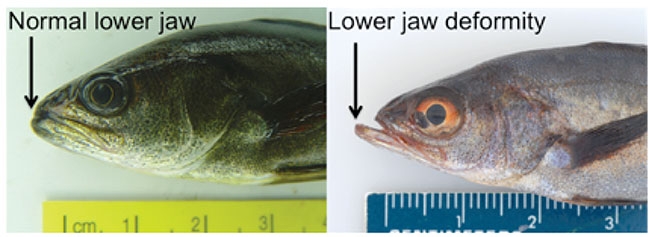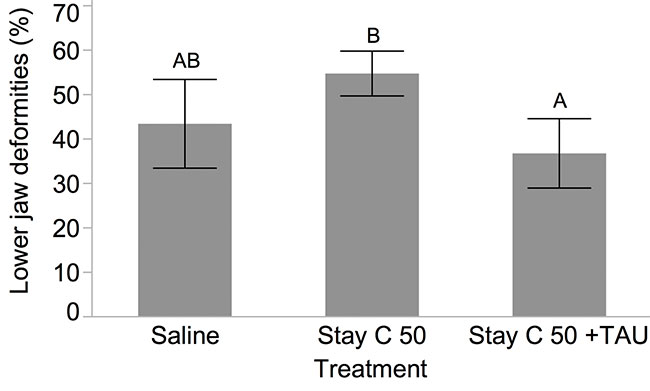
News & Views
Research
Vitamin C-taurine combo combats malformation in juvenile white seabass
White seabass (Atractoscion nobilis) larvae fed with live feeds enriched with a combination of vitamin C and taurine metamorphosed into juveniles with less incidence of lower jaw deformity, according to a feeding study in the U.S.
July 5, 2019 By Ruby Gonzalez
 White seabass with normal lower jaw and lower jaw deformity. White seabass (Atractoscion nobilis) larvae fed with live
White seabass with normal lower jaw and lower jaw deformity. White seabass (Atractoscion nobilis) larvae fed with liveDr. Matthew Hawkyard et al conducted the study, “Live feeds, enriched with taurine and vitamin C, fed to fish larvae affect subsequent juvenile malformation rates.”
Their research partners at Hubbs-SeaWorld Research Institute grow the species for stock enhancement for the Southern California fishery. Hawkyard, a research associate at Oregon State University’s Coastal Oregon Marine Experiment Station, told Hatchery International that the state of California prohibits the release of malformed fish.
During various stages from day two post-hatch till the end of the trial on day 60, the animals were fed rotifers, Artemia and commercial-type diet.
Two feeding trials were conducted spanning various stages from day two post-hatch to end of trial on day 60.
The first trial investigated the effects of vitamin C alone on the growth and survival of larval white seabass. The animals were fed rotifers and Artemia, enriched with liposomes containing either a saline solution or vitamin C.
Larval growth and survival were not impacted by the enrichments.
The second trial investigated the delayed impacts of dietary vitamin C, with and without additions of taurine, on larval growth as well as subsequent malformation rates of juveniles.
The animals were fed rotifers and Artemia that were enriched with either liposomes containing a saline solution; liposomes containing vitamin C; or liposomes containing vitamin C and taurine. Eventually, all animals were transitioned onto a common commercial-type microdiet, which was their sole source of nutrition until they reached the juvenile phase.
Larvae fed vitamin C-enriched live feeds had the highest malformation rates, observed during the juvenile phase. However, malformation rates observed in juvenile fish decreased considerably when the fish had been fed live feeds enriched with a combination of vitamin C and taurine.
Looking into the deformity in juvenile seabass comes at a time when the survival rates in larviculture have significantly improved. Hawkyard said there was a time when a 10 percent larval survival rate from egg was considered a reason to be “happy”.
He said, “Of course that’s still an issue for a number of species but for a handful of commercially important species, such as seabass and Seriola, the survival rates have gone up significantly in the past few years.”
With the increase in survival rate, they have started noticing greater numbers of animals with malformations. “From a food fish perspective, this issue has more to do with larval and juvenile quality, and improvement in this area leads to greater culture efficiencies and improved animal welfare,” he said.
The research utilized microencapsulation (liposome) technology to deliver the water-soluble nutrients to the fish larvae. This addressed the problem of many essential nutrients being water-soluble and, consequently, being lost very rapidly from artificial diets when suspended in water.
“Liposomes are microparticles that are similar in size to marine microalgae and so they can be fed to things like rotifers and Artemia. We found that
liposomes show very high retention of water-soluble nutrients when suspended in water and are ingested and digested by rotifers and Artemia,” he said.
“Likewise, liposomes are a very good tool for manipulating the water-soluble nutrients levels, such as vitamin C and taurine, in live feeds and allow us to address new questions pertaining to the dietary requirements of marine fish larvae.”
Print this page






